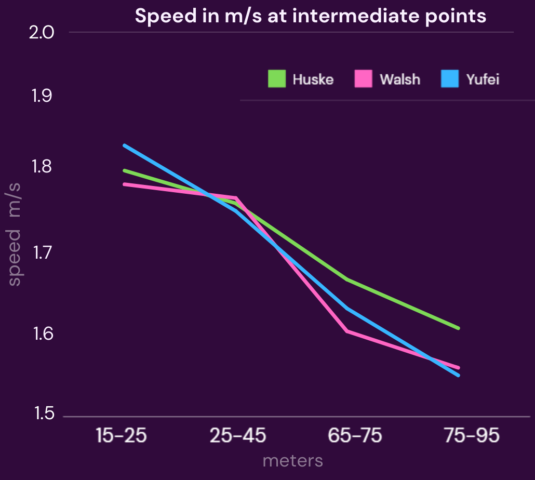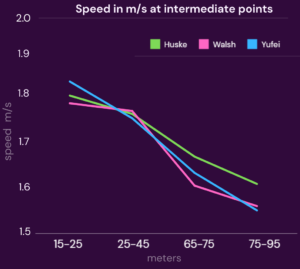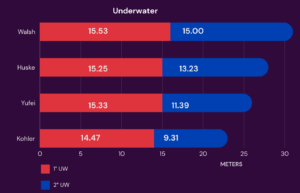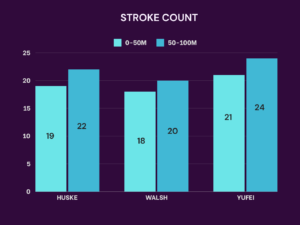The French Swimming Federation has released detailed statistics on all the swimming finals at the Paris Olympics, and in this article, we will analyze the women’s 100-meter fly final.
- See the 400 IM Breakdown Here
- See The 200 Fly Breakdown Here
- See The 200 Breast Breakdown Here
- See The 200 IM Breakdown Here
- See The 200 Free Breakdown Here
The women’s 100 fly was one of the most anticipated events at the Paris Olympics. A few weeks earlier, at the US Trials, Gretchen Walsh set a new world record for this distance with a time of 55.18. The second swimmer to qualify at the trials was Torri Huske, who held a personal best of 55.64 (2022) at that point.
We do know how this race ended up: Gretchen Walsh, whose best time was almost half a second faster than the best fly swimmers in history, lost the Olympic title.
From the graph below, we can already identify key points to analyze in order to understand the errors and effective strategies used in this race. For instance, it shows:
- The rapid reaction at the start by Zhang Yufei
- The excellent turn and push off the wall by Gretchen Walsh
- The consistency of Torri Huske
- The loss of speed by Gretchen Walsh in the second half of the race

Let’s break it down meter by meter
We will analyze the race by dividing it into two parts. In the first part, we look at “non-swimming” actions, such as the start and underwater phases. In the second, we focus on the swimming phases, the turn, and the finish.
NON-SWIMMING PHASES
Start
| Swimmer | Reaction Time (s) | Exit Speed (m/s) |
|---|---|---|
| Torri Huske | 0.63 | 2.94 |
| Gretchen Walsh | 0.75 | 3.00 |
| Zhang Yufei | 0.66 | 2.95 |
-
- Looking closely, Gretchen Walsh‘s start, slower by about 0.1s compared to her rivals, could be one of the factors that contributed to her second place.
- Despite this, her dive and underwater phase allowed her to reach the highest speed among the three, peaking at 3 m/s.
Underwater Phases
| Swimmer | Underwater Time (s) | Above Water Time (s) |
|---|---|---|
| Torri Huske | 0:12.76 | 0:42.83 |
| Gretchen Walsh | 0:13.27 | 0:42.36 |
| Zhang Yufei | 0:11.77 | 0:44.44 |
| Angelina Koehler | 0:10.45 | 0:45.97 |
- This chart clearly shows how important the underwater phase is for U.S. swimmers.
- Gretchen Walsh swam more than 30% of her race underwater, compared to 28% for Torri Huske and 26% for Zhang Yufei.
- Walsh was also the only one to reach 15m underwater after the turn.
However, the distance covered underwater is not the only factor favoring the Americans. The speed gained with it is crucial. In Walsh’s case, it is interesting to note that her second speed peak, unlike her rivals, occurred at the exit of the second turn (1.85 m/s), not during the swim.
SWIMMING PHASES
25-Meter Standings
- Zhang Yufei 11.35
- Gretchen Walsh +0.09
- Torri Huske +0.16
45-Meter Standings
- Gretchen Walsh 22.64
- Zhang Yufei +0.04
- Torri Huske +0.10
| Swimmer | Speed 15-45m (m/s) |
|---|---|
| Torri Huske | 1.796 |
| Gretchen Walsh | 1.791 |
| Zhang Yufei | 1.808 |
-
- As seen in the 25-meter standings and the average speed in the first lap, the fastest in the first part of the swim was Zhang Yufei.
- However, thanks to the speed gained from the underwater phase and the dive push, Gretchen Walsh, immediately catches up with her rivals, and despite a slightly slower swimming speed, reaches the 45m with a 0.04s advantage.
Turn and Push-off from the Wall
| Swimmer | Time from Flag to Turn (45-50m) (s) |
Speed upon Exiting the Turn (m/s) |
|---|---|---|
| Torri Huske | 2.83 | 1.75 |
| Gretchen Walsh | 2.76 | 1.85 |
| Zhang Yufei | 2.74 | 1.73 |
65-Meter Standings (Upon exiting the second underwater phase)
- Gretchen Walsh 33.50
- Zhang Yufei +0.57
- Torri Huske +0.69
The best combination of approach, turn, and push-off efficiency was by Gretchen Walsh, who gained more than half a second over her rivals in these technical 20 meters.
75-Meter Standings
- Gretchen Walsh 39.72
- Torri Huske +0.44
- Zhang Yufei +0.46
At 75 meters, the win is less certain for the 2002 swimmer, as her fellow Torri Huske has nearly halved the gap. Despite this, Walsh still leads the race with a 0.44s advantage. A lot for a swimmer. Or maybe not.
Final Phase
| Swimmer | Speed 65-95m (m/s) | Approach to the Wall (m) |
Arrival at the Wall (s) |
|---|---|---|---|
| Torri Huske | 1.643 | 0.71m | 0.43 s |
| Gretchen Walsh | 1.583 | 0.60m | 0.37 s |
| Zhang Yufei | 1.593 | 0.18m | 0.11 s |
95-Meter Standings
- Gretchen Walsh 52.55
- Torri Huske +0.02
- Zhang Yufei +0.54
As expected, and as confirmed by the graph, Torri Huske managed to conserve more energy than her teammate. While Huske, in the first part of the second lap, began gaining tenths upon tenths, Walsh continued to lose speed. A true fall if you look at the pink line between 50m and 75m in the pic.
The green line, representing Torri Huske, is the most consistent of the three, allowing her to get within a few hundredths of Gretchen Walsh just 5 meters from the finish.
Nonetheless, a more rapid final stretch for Gretchen Walsh, along with a slightly longer glide in the last two meters by Torri Huske, ultimately proved decisive.
The swimmer, already propelled by the highest speed—over 1.6 m/s in the last part of the race—gave nothing away in the final meters, and with an excellent finish, she gained crucial hundredths over her opponent. Walsh’s finish wasn’t terrible; the last 5 meters were swum in 3.08 seconds by her and 3.02 seconds by Huske. However, due to the disadvantage accumulated in the return lap, those 0.06s allowed her teammate to touch the wall first.
PODIUM
- Torri Huske 55.59
- Gretchen Walsh 55.63
- Zhang Yufei 56.21
Bonus: Stroke Count
| Swimmer | Stroke rate (m/stroke) |
|---|---|
| Torri Huske | 1.79 |
| Gretchen Walsh | 1.83 |
| Zhang Yufei | 1.65 |
Gretchen Walsh with 38 strokes was the swimmer who took the fewest strokes in the entire 100. This was predictable based on observations of the significant distance swum underwater by the American. However, it’s not the only significant factor. Although Walsh was slower than her fellow Huske in swimming speed, with a lower stroke rate, she was the athlete who registered the greatest distance covered per stroke cycle. In the segment between 25 and 50 meters, Walsh advanced about 1.94m per stroke cycle, with a total average of 1.83m per stroke over the 100, compared to Torri Huske‘s 1.79m per stroke and Zhang Yufei‘s 1.65m per stroke.



Shouldn’t the headline be Walsh’s “overwater” wasn’t enough to win her the gold?
Forget about all this. Old news. WE WANT to see Gretchen at world cups and SC Worlds!!!!! There should even be an article of what-ifs on what she could do at those meets!
SCWorlds mean little compared to the Olympics. We will barely send half a team.
But is SC season so we should talk about SC!!
Any analysis of stroke count or distance per stroke without some reference to height and arm span is pretty useless.
Lots of metrics but not tied to the most important fact-Tori developed a plan to change her approach from going out hard and hanging on which led her to finish 4th at Tokyo. She had great coaching and trained for this. The Paris pool was so shallow it slowed down the race. Gretchen didn’t lose the race, Torri won it with America finishing 1st and 2nd!
Is the “Underwater Phases” chart saying the top 3 all went beyond 15m off the dive or am I not reading it correctly?
I asked myself the same question when analysing the men’s races. I have written to the FFN which has not yet responded. In my opinion, the sensors are underwater. Extended arms can exceed 15 meters underwater but it is the head that counts for the 15-meter rule.
That’s gotta be it. I’d imagine for someone like Walsh, her head breaking out at 15m means her hands might break out at nearly 16m.
Thanks!
I didn’t know anything about underwater sensors.
If you ever get a response it would be interesting to know.
where can I access this kind of data? Is it public?
All good
All that matters to me is that she got her gold eventually
54 in Singapore
If GW had kept her head down from the flags in she might’ve gotten in there. That was where Huske won it. GW was going up and down hard. Amateur mistake, similar to Alex in the 200 IM. Good learning moment for her for sure.
I call that serpentine, when a tiring butterflyer is curling and thrashing more up and down than forward, Head low seems to be the best method to avoid it. I know they’re in trouble when the full neck is visible
SHE BREATHED EVERY SINGLE STROKE FLAGS IN!!!! HUSKE DID NOT!!!!!!!! This is 10 and under knowledge……
Summer McIntosh often breathes every stroke as did Phelps routinely… seemed to work out well for them. Speed is key, and access to oxygen helps.
Breathing into wall doesn’t (one stroke). By the time you’re up for a breath during the last stroke, .5 seconds later you touch the wall
None of the incoming oxygen from flags to finish is getting to the muscles during the race. If head down is faster (that’s a different analysis) then just toughen up and do it!
Flags to finish is more specific than “flags in”. There are 3 of those in a 200 before the finish.
The comment was made specifically in reference to Walsh breathing every stroke to the finish as Huske went past her to win. Head down might have gotten her the win.